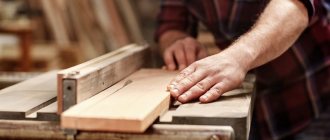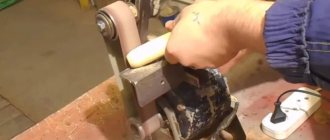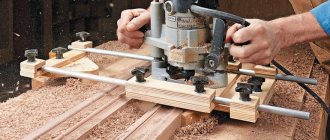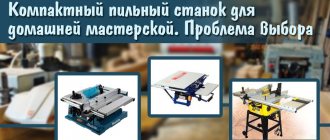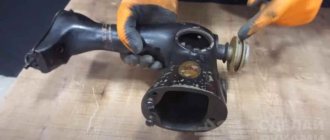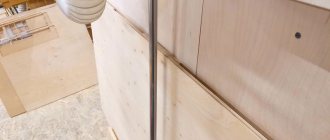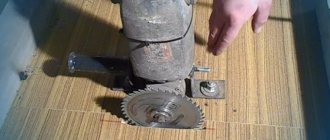A person who loves to create and make things on his own will get great pleasure from creating a router table. This is a rather difficult, but exciting task. Making a table for a router yourself means getting a structure that costs much less than one made at the factory. When producing a milling table, it is imperative to follow safety precautions.
The milling table is designed for processing materials, cutting shaped holes, and making joints. A table made by yourself will be more economical and much more convenient than a purchased one.
Work in which it is necessary to perform milling is always associated with the movement of the tool along the surface of a rigidly fixed workpiece. However, when you need to mill a part with small dimensions, some difficulties arise. To solve this problem, you can make a table for the router yourself. In this case, the tool will have a stationary mount; the workpiece itself must move. As a result, it will be possible to quickly carry out end processing and remove overhangs.
Standard milling table
Diagram of mounting the router to the tabletop.
The simplest way to create a table for a router is to mount the router directly to the tabletop. Fastening occurs through a drilled hole. This setup has proven to work well. In this case, the router is located at an angle of 90° to the tabletop; it is rigidly fixed to the table, which dampens excessive vibration.
Such an installation is considered the best if the milling cutter has a solid base and if it has the ability to regulate the immersion of the tool. The base of the router must be fixed to the tabletop so that the router can be lowered to the required depth. This installation method has some disadvantages that need to be kept in mind.
Firstly, the thickness of the table top affects the working range of the tool; it allows you to work with cutters that have long shanks.
Secondly, the work is limited by the single diameter of the hole for attaching the cutter.
And lastly, if you have one router, its constant installation and removal, changing the cutter, and adjusting the height is very inconvenient.
Milling table with built-in router for the workshop
The most popular and least expensive option for use in a wide variety of workshops (home and small industrial) is the option of a manual router built into a special work table. The versatility and quick reconfiguration for manual milling with a sufficient level of quality and individual solutions have made such milling machines extremely popular both among home craftsmen and among small production workshops. Some of the milling cutters already have a built-in microlift, which simplifies its use and is extremely convenient to use.
Using such a table in combination with a manual router when processing wood products allows you to achieve excellent results, with quality at the level of professional milling machines.
Bed production
Scheme for manufacturing a frame for a milling table.
The bed is understood as the main part, without which not a single router table can do. To make it, a variety of materials are suitable. You can use metal profiles, MDF boards, wood, etc.
Perhaps the best option would be to use a metal profile. Existing butt joints are secured only with bolts during assembly. Welding work is excluded. The design will be highly reliable, it will be technologically advanced and easy to assemble.
The dimensions of the bed do not have fixed dimensions; they are selected by each craftsman purely individually. The main criterion will be the size of the parts that have to be processed. To accurately determine the dimensions of the bed, it is best to make a small sketch.
In order to make it convenient to work, the frame needs to be deepened into the floor by about 15 cm. The most important parameter of the table is its height. The optimal length would be 1 m. To get maximum convenience, it is worth equipping the table for the router with adjustable supports.
Wood milling machine.
Functional
Using a milling machine, you can successfully perform various technological operations such as:
- straight edge profiling;
- milling of shaped profiles;
- creating curly ends according to a template;
- high-quality and accurate preparation of seats for dowels, door locks and hinges, awnings and any other fittings;
- sampling of a quarter (rebate);
- creation of tenons and grooves of various configurations (dovetail type, T-shaped, V-shaped, micro-tenons and others);
- cutting blanks and cutting them into pieces of the required length;
- leveling the surface of the workpiece (for example, a slab - a table top);
- wood carving and engraving, for which manual and manual milling cutters are actively used;
- making grooves of both straight and spiral types on the surface of products that have the shape of bodies of rotation (balusters, etc.).
Milling machine device
The industrial machine has wide functionality, a reserve of capabilities, high accuracy and multiple settings. The photo shows the Powermatic TS29 1791284-PMRU milling machine
This machine is equipped with a carriage, a powerful 7.5-kilowatt motor and can work with tools with a diameter of up to 300 mm, which makes it extremely versatile.
1. Bed
The frame of the milling table is its support, and the support must first of all be stable. On full-fledged industrial milling machines, the bed is made of cast iron or steel.
2. Motor (milling cutter) and options for its installation Types of motors or milling cutters —
There are two types of drives used in milling machines:
- Directly permanently installed engines (or trimmers).
For example, a JET or other engine installed in an elevator:
- Or hand cutters
For example, as shown in this photo, a Festool OF 1400 manual router is used:
3. Working surface of the milling machine
Functionally, the working surface must first be rigid - always maintain flatness and not bend. And secondly, ensure good sliding of the workpiece over the surface without damaging it (do not scratch). Therefore, the working surface of a milling machine can be made of cast iron, steel, or aluminum. For home workshops and mobile tables, countertops made of laminated chipboard, laminated MDF or plywood are usually used.
The inclined tabletop has great potential, allowing you to make more complex profiles with ordinary cutters and make unusual tenon joints.
Options for installing and fastening the router in the working surface: Option 1. Stationary version with fastening to a removable plate for convenient dismantling of the router. A solid aluminum plate can be used, as in the original Festool CMS base:
as well as in homemade
Or compact aluminum/PTFE plate:
Option 2. Height-adjustable router installation. For this option, different elevator designs are used.
- ELEVATOR variant with a lever having a vertical axis:
Homemade versions of elevators do not lag behind their serial counterparts in creativity:
- ELEVATOR variant with a disk or lever having a horizontal axis: Elevator
— rotary unit for the milling table
Milling machine equipment
Equipping the working surface of the table: using additional accessories, you can significantly expand the capabilities of milling machines (tables) for wood and produce parts of increased complexity. 1. Parallel (side) stop First of all, the milling machine must be equipped with a side stop, which allows for straight-line milling.
The side stop limits the depth of cutter penetration into the workpiece. It is installed, as a rule, on two guides attached to opposite ends of the table.
The cheeks of the side stop are usually made of laminated MDF, plywood or dense wood to ensure smooth and delicate sliding of the workpiece along them. A comb and stops can be installed on it to hold the workpiece:
The side stop can come complete with a positioner (for example INCRA), which allows you to precisely set the stop relative to the cutter:
2. Carriage or floating stop
The carriage expands the functionality of the milling machine and allows, for example, making a tenon joint. By design, this element has different options:
It can be used to mill parts that have an indirect angle. There are special floating stops for making tenon joints. It allows you to fix the workpiece in a certain way and set the profile of its ends to create a tenon joint. For example, the INCRA I-BOX device:
3. Clamping and fixing devices . These devices clearly fix the workpiece in the desired position, limit the dimensions of milling and protect people from injury. Of course you can work like this:
But it is correct to work with combs, clamps, clamps and pushers:
For massive workpieces this becomes especially relevant:
Homemade options are simpler, but generally functional:
Cover device
Scheme for making a cover for a milling table.
A kitchen countertop made of chipboard with a thickness of 40 mm is best suited for this part. This material perfectly dampens vibration, it has a hard, absolutely smooth surface on which the workpiece moves perfectly.
Modern phenolic plastic of high hardness is also suitable for the production of the lid. It has an absolutely flat surface and is not afraid of moisture. Plastic does not cause any difficulties in processing, which makes it possible to make grooves where aluminum profiles and stops will be installed. The only drawback is its high cost.
To make router tables more reliable for long-term use, you can make an aluminum tabletop. This material never corrodes and is lightweight. But before manufacturing, aluminum must be clad so that there are no dirty marks left on the workpieces.
Plates for installing the router into the table
Drawing of a plate for installing the router to the table.
Router tables have the plates needed to mount directly into the table. This method has several advantages.
Due to the fact that the plate is no more than 10 mm thick, it is possible to easily get the router to replace the cutter.
You can use additional insert plates to make it possible to use different cutter diameters. Such an insert plate can become a support plate during the operation of milling surfaces on large parts. The plate gives the router increased stability; the use of plates helps to mill wide grooves of parts.
Inserting the plate is quite difficult. It is necessary to first drill a mounting hole in the table to obtain a tight fit for subsequent insertion of the plate. When there are large gaps, increased vibration occurs. If the plate does not have a reliable, tight attachment to the table, milling accuracy will not be maintained. Drilling a hole too large into the top of the router table you are making will cause it to weaken. Therefore, when calculating the diameter of the hole, care must be taken to create reinforcement for the tabletop. It is of great importance that the table top and insert are made flush. Additional gaskets, washers, etc. will help cope with this problem.
Clamping fixtures and lift
Elevator diagram for a router.
Router tables can also be made using jigs. The router is installed in the tabletop, with a shallow drilled hole. The diameter of the hole is equal to the size of the base of the router. The router itself is secured in three clamping fixtures.
The advantage of this method is the quick assembly and disassembly of the router. However, there are also several disadvantages. First of all, this is due to the limited diameter of the hole for the tool, so you have to use only cutters of a specific size. It is necessary to look under the table all the time when setting the router to a certain height.
An additional element required by a milling table is a universal plate.
This part is used by all routers equipped with a built-in lift. The main advantage of such a router is the mechanized lift. As a result, it is possible to adjust the height of the tool above the main surface of the table. You can even raise the engine to replace the cutter.
Before purchasing such a plate, it is important to know a few nuances. First of all, the installed elevator will interfere with the installation and removal of the router. A lift always means added weight. An elevator lift is very expensive, but it will ensure more accurate production of parts.
Various designs
The lightest milling table is considered to be made from a chipboard sheet with a hole for the tool. A wooden guide is mounted to the table, secured with ordinary clamps. Such a design can be easily mounted on a table, installed between stools, and so on.
Craftsmen make milling tables from ordinary 15 mm plywood. The table consists of several parts. You need a lid, a couple of walls, several support bars (usually four), one long block needed to attach the router table directly to the workbench. In the case of an ordinary table, you need to hollow out grooves in the walls in advance in order to install clamps.
https://vsyavagonka.ru/youtu.be/lJs9pa6shFo
There is a special niche in the table top for the cutter. It is made in the shape of a semicircle. This groove can be easily made with a small hacksaw. Holes are drilled into which the mounting screws will go, as well as a movable stop mounted on the table, which is secured with bolts.
Carpenter's router table from a manual router
In search of a worthy answer to the discomfort that arises when working with hand-held milling tools, owners of home carpentry eventually come to the need to purchase a convenient milling table.
VovroKsyuUser FORUMHOUSE
I've been thinking about the table for a long time. Especially after I manually milled 22 m of fence.
The purchase option can be expensive; the dimensions of a machine assembled in a production environment do not correspond to the size of a small home workshop. The optimal solution in this case would be to assemble the milling table yourself.
Those who want to make a homemade milling machine will find drawings and step-by-step instructions in the corresponding FORUMHOUSE section.
How to make a milling table
A homemade milling table is a simple machine for processing wood. The main working unit in it is a manual milling machine. Working with hand-held power tools involves moving the working cutter along the surface of a stationary workpiece (which is not always convenient). A milling table for hand tools allows you to change the processing method and mill in a lightweight way: the hand tool is fixed on the work table, and the workpiece is easily fed to the cutter by hand.
A milling table for a manual router consists of basic and additional elements. Additional elements are not required, but their use makes it possible to make the technician’s heavy work as easy as possible, make the design of the device safer, and make the functionality closer to the capabilities of serial installations.
Universal milling table: basic design elements
The main elements of the milling table are indicated in the figure.
A homemade milling table is a simple machine for processing wood. The main working unit in it is a manual milling machine. Working with hand-held power tools involves moving the working cutter along the surface of a stationary workpiece (which is not always convenient). A milling table for hand tools allows you to change the processing method and mill in a lightweight way: the hand tool is fixed on the work table, and the workpiece is easily fed to the cutter by hand.
A milling table for a manual router consists of basic and additional elements. Additional elements are not required, but their use makes it possible to make the technician’s heavy work as easy as possible, make the design of the device safer, and make the functionality closer to the capabilities of serial installations.
Universal milling table: basic design elements
The main elements of the milling table are indicated in the figure.
Aib User FORUMHOUSE, Moscow.
I really needed a mobile milling table. I welded the frame, painted and assembled the structure.
The dimensions of the milling table depend on the dimensions of the parts being processed, as well as on the height of the craftsman himself. The length and width should be slightly smaller than the tabletop, and the height of the bed is 850...900 mm, which corresponds to the most comfortable conditions for standing work. The homemade legs can be made adjustable, which will allow you to compensate for uneven floors or change the height of the bed.
Tabletop for router
The dimensions of the tabletop depend on the size of the parts being processed.
dautovFORUMHOUSE user
In a home workshop, a small table of 500x500 mm is sufficient.
To process relatively long parts (for profiling edges on door frames), you will need a tabletop of the appropriate size. Let's look at the drawing:
For the manufacture of the frame, wood-based materials are most often used, which can effectively dampen vibrations. This could be a countertop made of chipboard, which is used in the manufacture of kitchen furniture, or a sheet of thick plywood. Here, for example, is a countertop made from chipboard scraps formed after installing a kitchen sink.
Krott64FORUMHOUSE user
With this tabletop scrap, after some simple modifications, you can do some pretty decent things.
Some people make countertops from metal, others from edged boards, but, as practice shows, chipboard and plywood are always a priority.
Orfo74FORUMHOUSE user
If I make it, it will be from laminated plywood (I have one like this on my trailer). I have already traveled hundreds of thousands of kilometers under the heat and below zero. Neither salt nor rain spoiled it. And it can still be used, but you need to assemble it either in 2 layers, or make the bottom out of simple plywood.
To make a countertop, you cannot use material that has defects on its surface (knotty boards, etc.).
Mounting plate for hand router
A hand router is attached to the mounting plate using threaded connections. Therefore, its production must be taken with full responsibility. The material from which the plate will be made must be strong enough so that the router does not tear out during operation (the consequences can be imagined). This can be a rectangle made of metal or plywood sheet (but metal is more reliable).
AlekXFORUMHOUSE user
A powerful car has a lot of dope. And if she turns out of the table while working, it won’t seem too bad.
– not recommended, because the thicker the plate, the smaller the vertical overhang of the cutter.D
DgusepeFORUMHOUSE user
The legs can be made of wood, but it is advisable to make the tabletop from 3 mm metal. For maximum cutter lift.
The length and width of the mounting plate must correspond to the dimensions of the base of the hand router, with which the power tool will be attached to the table.
Longitudinal workpiece stop
The longitudinal stop can be made from a regular sheet of chipboard or from an edged board. The stop must be made movable to ensure the possibility of adjusting the horizontal reach of the cutter. For more precise adjustment, you can attach measuring rulers to the sides of the tabletop.
The design of the locking mechanism, which allows you to secure the longitudinal stop in the required position, is extremely simple. It can consist of two slats with through longitudinal grooves and two threaded fasteners with wings.
Instead of slats, you can use two metal corners, which will last longer and will not deform under the action of clamps.
To prevent dust and chips from interfering with work, it is advisable to equip the longitudinal stop with a dust collector, to which a chip extractor or a small carpenter's vacuum cleaner is connected.
The longitudinal stop can be made double, which significantly expands the functionality of the milling table.
SuperkuzenFORUMHOUSE user
The monolithic stop makes it impossible to carry out a lot of operations performed on the milling table, that is, it makes the table of little functionality.
A milling table can perform the functions of a small jointing machine if an adjustable difference between the working planes is arranged between the two halves of the longitudinal stop. This design allows you to move one half of the stop relative to the other, setting one stop flush with the cutter using thin wooden plates. Adjustment plates are placed under the non-working surface of the stop.
Manual milling machine
The performance of the milling table will directly depend on the technical characteristics of the hand tool (power, number of revolutions per minute, etc.). You should choose a router for a milling table based on the expected load. The additional functionality of the machine will be an additional advantage for the master. If you don’t yet have a manual milling cutter, then choose a tool with an adjustable cutter rotation speed and the ability to set the processing depth (plunge-beam milling machines). Very easy to use machines with a spindle lock (for easy replacement of cutting tools), as well as devices with soft start and quick stop of the spindle.
We looked at the main elements of a milling table, which will allow the owner to perform the simplest milling operations. In order to expand the functionality of the device, make it universal and increase operational safety, it is necessary to ensure the availability of additional devices. Let's look at the most common of them.
Longitudinal guide for movable milling carriage
Using a longitudinal guide built into the surface of the table top, you can attach a variety of devices to the milling table: an angular stop with a protractor, a perpendicular stop, etc.
The longitudinal guide can have a different design, but most often it is an aluminum C-shaped profile into which bolts and wing nuts are inserted. This design allows you to quickly install the device you need at the moment on the milling table.
By the way, using the C-shaped profile, you can also attach a longitudinal adjustable stop to the tabletop.
Vertical clamp
The upper clamp increases safety when working with a homemade router and increases processing accuracy. Its fastening can be implemented using the type of clamps for a movable carriage.
If you are planning to make a router table with your own hands, a video about setting up a universal carpentry workshop for personal use will help you with this.
Lift for router
The vertical reach of the cutter very often has to be adjusted. To perform this adjustment, a milling lift is provided - an adjustable stop that allows you to maintain the milling machine at a given height and, if necessary, quickly change this height.
It is advisable to use a milling elevator in conjunction with submersible milling machines. Their design initially has guides for adjusting the reach of the cutter (unlike machines with a fixed motor).
A lift for a homemade router can have different designs.
Car jack lift
You can use an old car jack to create a lifting mechanism.
leon42FORUMHOUSE user
The elevator can be made from a car jack: there is a shelf under the router, and we attach the jack to the shelf. We turn the jack - the router rises or lowers.
For convenience, the jack handle can be moved out of the side wall of the bed. This will make adjustments much easier.
Threaded rod lift
Blackk FORUMHOUSE user
The angle with the threaded rod is screwed to the protrusion on the router, to which the measuring pin is normally attached. The corner for the threaded rod is threaded. By rotating the pin, we seem to screw into the corner and pull the entire router up along the guides. Accordingly, when rotating backwards, we lower the router.
In this case, the threaded rod has a recess for a hex key.
Elevator based on threaded wedge
Another effective and easy to implement elevator design.
The mechanism consists of a wooden wedge (item 1), in which a through hole is drilled for a screw (item 2). Thanks to metal plates (item 3), attached to the sides of the wedge and having threaded holes, the wedge moves in a horizontal plane, raising or lowering the milling machine. The handle of the lifting mechanism is located on the side surface of the bed. To reduce the load during lifting, the router is equipped with a homemade roller (item 4).
Turning the router table on and off
All necessary equipment for the electrical part of the milling table is already provided in the design of the milling machine. The only thing that can be added to an existing electrical circuit is a remote switch and an emergency shutdown button (after all, no one has yet canceled the safety rules during operation).
You can use a very ordinary switch for the router. As for the possibility of quick shutdown: it can be realized by installing an emergency button with a locking mechanism on the table (in which the unlocking is carried out by turning).
Table assembly
We have listed the main and auxiliary elements of the milling table. Each master can determine the order of assembling the device for himself. The only point to pay attention to is the manufacture and installation of the mounting plate.
After a plate of a suitable size is cut from a steel (or plywood) sheet, it is necessary to drill holes in it for attaching the milling machine, a hole for the cutter (its diameter must correspond to the diameter of the hole in the base of the router) and mounting holes (for attaching the plate to the tabletop) .
The base of the router has threaded holes for fixing the plastic cover. These holes can be used to attach the router to the mounting plate using countersunk screws (the stock plastic trim is removed).
If there are no mounting holes in the base of the router, then metal clamps or standard fixtures provided for by the design of the router can be used as fasteners.
The mounting plate must be flush with the tabletop. Therefore, a recess of appropriate dimensions should be made in the tabletop.
If you have already assembled a milling table with your own hands, we invite you to share your personal manufacturing experience in the appropriate FORUMHOUSE section (there you will find instructions and drawings). People who have seriously decided to master carpentry will be interested in an article about what tools they need to have in their carpentry or furniture workshop. And a video about the design of a homemade milling table and the features of power carpentry tools will help you find answers to questions regarding equipment that is extremely rarely used in a small home workshop.
